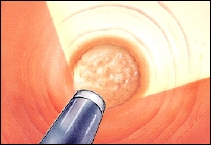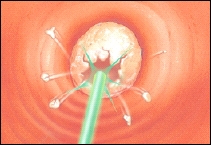Treating Kidney Stones: Ureteroscopic Stone Removal
Treating Kidney Stones: Ureteroscopic Stone Removal
Ureteroscopic stone removal may be done before, after, or instead of other treatments. If you need this procedure, your healthcare provider will discuss its risks and possible complications. You will be told how to prepare. And you will be told about anesthesia that will keep you pain-free during treatment.
Removing the stone through the ureter
Ureteroscopic stone removal extracts a small stone in your ureter without an incision. Your doctor places a viewing tube (ureteroscope) in your ureter. A wire basket inserted through the tube removes the stone. Sometimes, a laser or a mechanical device is used to break up the stone. A soft tube may be left in your ureter briefly to drain urine.
Your recovery
This is an outpatient or overnight procedure. For a few days after surgery, you may feel some pain when you urinate. Or you may need to urinate more often, or have bloody urine. You may have a ureteral stent. This is a soft tube that prevents blockage from swelling after the procedure. The stent is removed when the swelling goes down, often within days. Follow up as instructed to check for any new stones.
When to call your healthcare provider
Call your healthcare provider right away if:
You have sudden pain or flank pain
You have a fever over 100.4°F (38°C)
You have nausea that lasts for days
You have heavy bleeding when you urinate
You have heavy bleeding through your drainage tube
You have swelling or redness around your incision
Updated:
June 18, 2017
Sources:
Management of Uretera Calculi. UpToDate.
Reviewed By:
Latif, Walead, DO,Walton-Ziegler, Olivia, MS, PA-C


